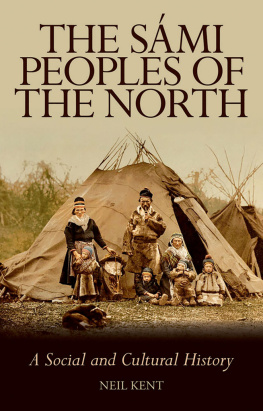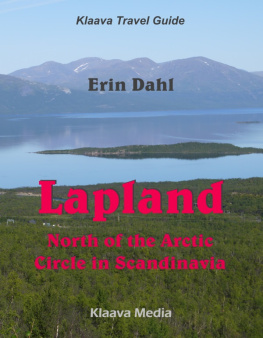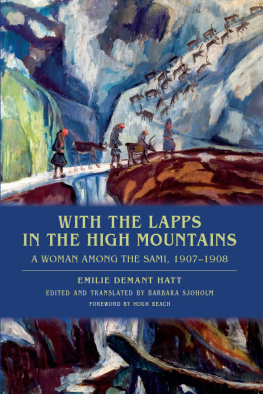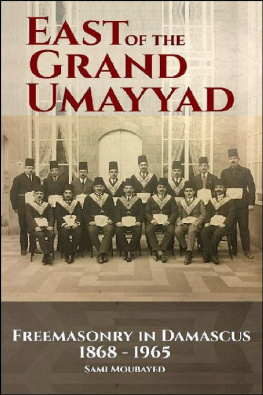THE SMI PEOPLES OF THE NORTH
NEIL KENT
The Smi Peoples of the North
A Social and Cultural History

HURST & COMPANY, LONDON
First published in the United Kingdom in 2018 by
C. Hurst & Co. (Publishers) Ltd.,
41 Great Russell Street, London, WC1B 3PL
This paperback edition published 2018
Neil Kent, 2018
All rights reserved.
Printed in India
Distributed in the United States, Canada and Latin America by Oxford University Press, 198 Madison Avenue, New York, NY 10016, United States of America.
The right of Neil Kent to be identified as the author of this publication is asserted by him in accordance with the Copyright, Designs and Patents Act, 1988.
A Cataloguing-in-Publication data record for this book is available from the British Library.
ISBN: 9781787381728
www.hurstpublishers.com
CONTENTS
I would especially like to thank Professor Leif Rantala (formerly of the University of Lapland, Rovaniemi, Finland), and Dr Inga-Maria Mulk (formerly of the jtte Museum, Jokkmokk, Sweden), who expended many hours assisting me with this book. Others who enriched my research include Professor Tim Bayliss-Smith (University of Cambridge), Professor Knut Helskog (Troms Museum, Troms, Norway), Tarmo Jomppanen (director of the Smi Museum, Ivalo, Finland), Jouni Laiti of the Smi Council and Leena Jansson (University Library, Helsinki, Finland). Above all I am grateful to the Nordic Culture Fund, Copenhagen, which provided the resources to make my research and this book possible.
This book is intended for both an academic as well as a more general audience. I endeavour to give a general overview of the Smi throughout their history, whilst at the same time homing in on more detailed aspects of their life. While I am fluent in all the major Nordic languages and Russian, I have also endeavoured to acquire some knowledge of Northern Smi, but am no professional linguist in this area. Most Smi names have been provided in Northern Smi but there are occasional inconsistences, in particular, when sources using other Smi dialects have been included.
What is Spmi?
On 4 February 2009 an article appeared in the Daily Telegraph entitled Family Adventures in the Arctic Wilderness, about the visit of a British family to Swedish Lapland. The caption to the articles photograph boldly stated that Lapland is a largely unpeopled vastness that spans a northern swath of Sweden.
If one is to rely on data relating to research on DNA, however, it seems more likely that the ancestors of the Smi in fact came from Central Europe, even if their language came from the east, where the Finno-Ugric languages disseminated. In this latter context, the modern Smi and Finnish languages have a common Finnic linguistic ancestor spoken by both the Smi and the Finns at the beginning of the first millennium BC.
What constitutes an indigenous people is of course a complicated issue, and even when this is resolved for those concerned, their rights remain a matter of considerable dispute. For those who consider the area in the Nordic countries and north-western Russia known as Spmi to be their home, it is a subject of great import. After all, Spmi extends over a territory almost 400,000 square kilometres in size, with a Smi population, according to the Smi Parliament of Finland (there is no official census), of more than 45,000 in Norway, 20,000 in Sweden, 8,000 in Finland and 2,000 in Russiaa total of between 75,000 and 100,000 people.
To a certain degree, new peoples could be, were and continue to be absorbed into the Smi nation, but when their presence became overwhelming this process often meant not the absorption of the newcomers into the Smi, but that of the Smi into the wider general population. It has thus been said that Spmi, as it is today in the far north of Fenno-Scandia and the Kola Peninsula, is in fact the result of this negative process which began further south, when the Smi still resided in those areas.
Yet regardless of how they first became established in the region, the Smi have long perceived Spmi to be their homeland, one in which the intrusion of their southerly neighbours has been an unwelcome, and indeed overwhelming, experience. The Skolt Smi of the east, for example, trace their history on the Kola Peninsula back for millennia, a concept of historical identity which is reflected in the modern writings of the Smi there:
For a long, long time we have lived in the country of the North, where the sun did not shine. And the moon did not shine. It was a thoroughly dark country. Only the stars could be seen in the dark firmament And the people of this country did not know of fire. They lived on things from turf and twigs That is the way people lived in this land of darkness for thousands of years. And they will live there for thousands of years to come. And for a further thousand and yet another
Although it has been said by some that the word Kola derives from the Kildin Smi word koall, signifying gold, in this context a golden river, it seems far more likely that it refers to fish and that the signification is therefore Fishermans River.
Another highly specific northern physical characteristic of Spmi is the presence of the Aurora Borealis, or Northern Lights. It was previously believed that there was an old Smi legend according to which this natural phenomenon was caused by a fox which had stirred up a cloud of snowflakes by a flick of the tail, creating a dazzling reflection of the moonlight.
The Geography of Spmi
The Smi homeland stretches across a broad swathe of northern Fenno-Scandinavia, eastwards to the Kola Peninsula, in what is geographically known as the Arctic-Alpine zone. The high coastal mountains which skirt much of the region have a climate heavily influenced by the ocean and are cool and wet during the summers and cold and snowy during the winters. However, beyond them to the south and east, summers are typically of the continental type: drier and warmer than the coastal areas in summer but brutally cold in winter, with only four months during which the ground is free of snow cover. Its lakes are frozen for at least half the year.
A map of Lapland from 1594, which was the result of the surveying skills of an expedition led by the Dutch cartographer Jan Huyghen van Linschoten, is one of the earliest to show the geographical scope of the Smi homeland. More widely disseminated was another map of Lapland, including the Kola Peninsula, published that same year by the Dutchman Simon van Salingen and entitled Lappia par Norwegi, which had been commissioned by the Danish king, Christian IV, two years before.
The map at the end of Johannes Schefferuss book Lapponia, first published in Latin in 1673, depicts Lapland as extending down the shores of both sides of the Gulf of Bothnia, well beyond Ume and Nykarleby. The mountains of Sweden to the south-west, the Arctic Ocean to the north and the northern, western and southern shores of the White Sea are also included in this early printed work about the Smi. Born in 1621 in Strasbourg, then part of the Holy Roman Empire, the author eventually emigrated to Sweden where he became a professor at Uppsala University in 1648. His book, which is richly illustrated with copperplate pictures and includes depictions of Smi winter and summer clothing, ultimately became much more widely known than Olaus Magnuss monumental work of the previous century.

















